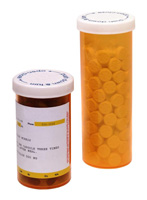 Deep
vein thrombosis (DVT) is an under diagnosed,
preventable medical condition that occurs when a
blood clot forms in a large vein. These clots
usually develop in the lower leg, thigh, or
pelvis, but can also occur in the arm. Deep
vein thrombosis (DVT) is an under diagnosed,
preventable medical condition that occurs when a
blood clot forms in a large vein. These clots
usually develop in the lower leg, thigh, or
pelvis, but can also occur in the arm.
It is important to know about DVT because it can
happen to anybody and can cause serious illness;
disability; and, in some cases death. The good
news is that DVT is preventable and treatable if
diagnosed correctly and early.
|
To learn more about DVT click on one of the following links or scroll
down the page.
|
|
 Materials: Materials:
Download and print a brochure about DVT facts:
 PDF
PDF
|
|
Q
Who is at risk for DVT?
A Almost
anyone can have DVT. However, certain factors can
increase the risk of developing this condition. The risk
increases even more for someone who has more than one
risk factor at the same time.
Following is a list of factors that
increase the risk of developing DVT:
- Injury to the vein, often caused by:
- Fractures,
- Severe muscle injury, or
- Major surgery (particularly involving the
abdomen, pelvis, hip, or legs).
-
 Slow blood flow, often caused by: Slow blood flow, often caused by:
- Confinement to bed
(e.g., due to a medical
condition or after surgery);
- Limited movement (e.g., a cast on a leg to
help heal an injured bone;
- Sitting for a long time, especially with
crossed legs; or
- Paralysis.
- Increased estrogen, often caused by:

- Birth control pills;
- Hormone replacement therapy, sometimes used
after menopause; or
- Pregnancy, for up to 6 weeks after giving
birth.
- Certain chronic medical illnesses, such as:
- Heart disease,
- Lung disease,
- Cancer and its treatment, and
- Inflammatory bowel disease (Crohn’s disease
or ulcerative colitis).
- Other risk factors include:
- Previous DVT,
- Family history of DVT,
- Age (risk increases as age increases),
- Obesity,
- Smoking,
- high blood pressure,
- A catheter located in a central vein, and
- Inherited clotting disorders. An inherited clotting
disorder might be suspected when a person has repeated
DVTs that cannot be linked to any specific cause (such
as recent surgery) or develops DVT in a vein at an
unusual location, such as a vein in the liver, kidney,
or brain.
[Return to top of page]
Q Can DVT be
prevented?
A Yes,
there are some steps that people can take to help
prevent DVT.
- Wear loose-fitting clothes.
- Drink plenty of water, and avoid drinking
anything with alcohol or caffeine in it.
Q
What complications can result from DVT?
A If part
of a blood clot breaks off, it can travel through the
bloodstream to the lung and cause a pulmonary embolism
(PE), which can be fatal.
In addition, nearly one-third of people
who have a DVT will have long-term complications (post-thrombotic
syndrome), such as swelling, pain, discoloration, and
scaling in the affected part of the body. In some cases,
the symptoms can be so severe that a person can become
disabled.
For some people, DVT becomes a chronic illness; about
30% of people who have had a DVT are at risk for another
episode.
[Return to top of page]
Q
Does DVT cause heart attack or stroke?
A No, DVT does not cause heart attack or
stroke. There are two main types of blood clots.
How a clot affects the body depends on
the type and location of the clot:
- A blood clot in a deep vein of the leg, pelvis,
and sometimes arm, is called deep vein thrombosis (DVT).
This type of blood clot does not cause heart attack
or stroke.
- A blood clot in an artery, usually in the heart
or brain, is called arterial thrombosis. This type
of blood clot can cause heart attack or
stroke.
Both types of clots can cause serious
health problems, but the causes and steps you can take
to protect yourself are different. To learn more about
arterial thrombosis, visit CDC’s information about
heart
disease and stroke prevention.
The information on this web page is about deep vein
thrombosis (DVT).
[Return to top of page]
Q
What are the symptoms of DVT?
A About
half of people with DVT have no symptoms at all. For
those who do have symptoms, the following are the most
common and can occur in the affected part of the body:
- Swelling,
- Pain,
- Tenderness,
- Redness of the skin.
If you have any of the symptoms above,
you should see your doctor as soon as possible.
[Return to top of page]
Q
What are the symptoms of pulmonary embolism
(blood clot in the lung)?
A With DVT,
a piece of the blood clot can break off and travel to
the lungs. A blood clot in the lungs is called pulmonary
embolism (PE). PE is very serious and can cause death.
- Symptoms of pulmonary embolism can include:
- Difficulty breathing;
- Faster than normal heart beat;
- Chest pain or discomfort, which usually worsens
with a deep breath or coughing;
- Coughing up blood; or
- Very low blood pressure, lightheadedness, or
blacking out.
If you have any of the symptoms above, you should
seek medical help immediately.
Unfortunately, there are other conditions whose
symptoms are similar to those of DVT and PE. For
example, muscle strains and swelling of veins close to
the skin can mimic the symptoms of DVT. Heart attack and
pneumonia have symptoms similar to those of PE.
Therefore, it is difficult to diagnose either condition
without tests.
[Return to top of page]
Q
How are DVT and pulmonary embolism diagnosed?
A
 DVT is
often diagnosed using: DVT is
often diagnosed using:
- Duplex ultrasound—It uses sound waves to
evaluate the flow of blood in the veins.
- Venography—If the duplex ultrasound does not
provide a clear diagnosis, a venogram, a type of X
ray, is used to look at the veins.
DVT also can be diagnosed using the
following, less frequently used, tests:
- In many cases, magnetic resonance imaging (MRI)
can provide information that would not show up on an
X ray. This test is being used more frequently to
diagnose DVT.
- A computed tomography scan is a special type of
X ray that can provide pictures of structures inside
the body. However, this test is rarely used to
diagnose DVT.
Tests to find the location of and damage
to the lungs caused by a pulmonary embolism (PE)
include:
- Computerized tomography (CT scan) of the lung, a
special type of X ray that can provide pictures of
structures inside the body.
- Pulmonary ventilation or perfusion scan, a
special test looks at how the lung is working and if
it is getting enough blood.
- Pulmonary angiogram, another special type of X
ray, to look for a blockage in the lung.
[Return to top of page]
Q What is the
treatment for DVT and pulmonary embolism (PE)?
A
 DVT
Treatment DVT
Treatment
Medication is used to prevent and treat DVT.
Anticoagulants (blood thinners) are the medicines
most commonly used.
Compression stockings (also called
graduated compression stockings) are sometimes
recommended to prevent DVT and relieve pain and
swelling. These might need to be worn for 2 years or
more after having DVT.
In severe cases, the clot might need
to be removed surgically. Pulmonary Embolism (PE) treatment
Emergency treatment at a hospital is
necessary to treat PE. In cases of severe,
life-threatening PE, there are medicines that can
dissolve the clot (thrombolytics) and medicines that
prevent more clots from forming (anticoagulants).
Surgery is sometimes needed for
patients at great risk having another PE.
[Return to top of page]
|